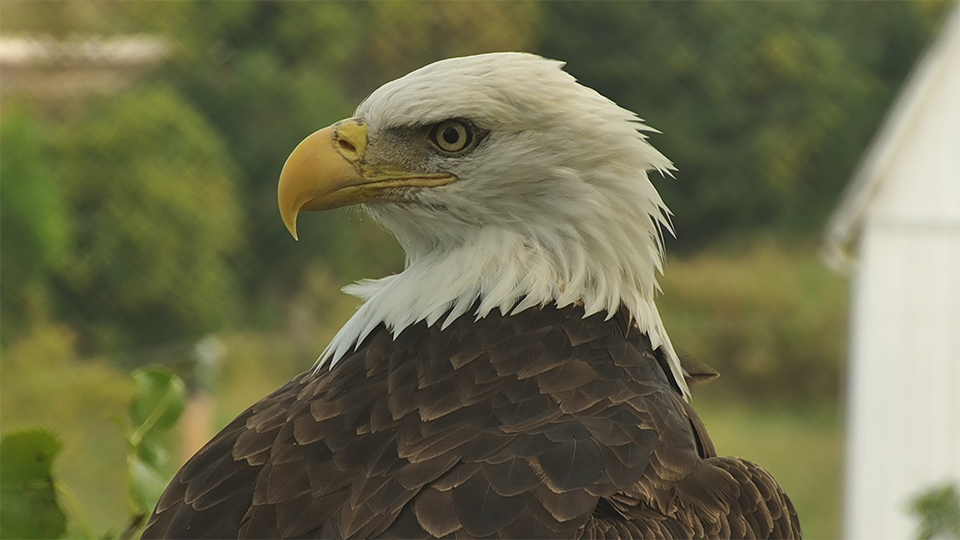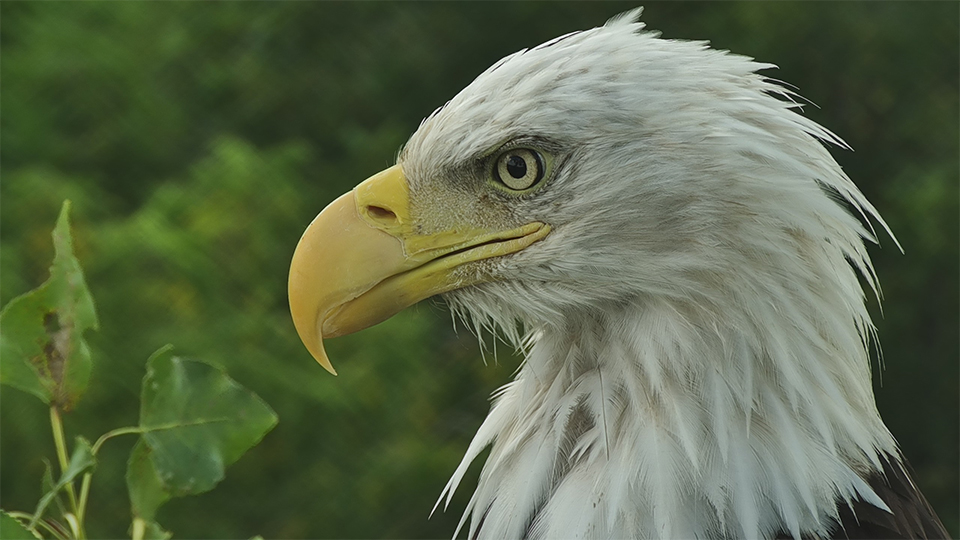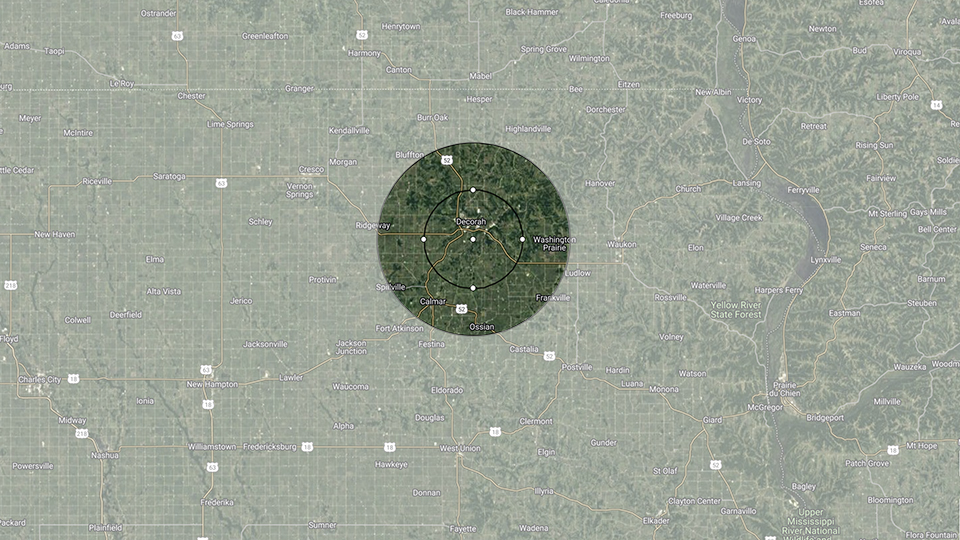Could HD or HM be one of Mom and Dad’s offspring? Mom and Dad’s oldest eaglet turned 14 years old this spring. Since bald eagles tend to nest in the region they were born, it’s possible that at least one of them was produced by Dad and OM, or Dad and Mom. But male and female eagles have slightly different nesting dispersal patterns, which makes male HD the more likely offspring choice.

HD on the Y-Branch! See that dark marking on his cere that looks like dirt? It isn’t. H/T to Camop Talon!
Natal dispersal in birds is defined as the movement between hatching location and first breeding or potential breeding location. Juvenile bald eagles disperse from their natal nest in late summer or early fall. They travel well-worn routes between their winter and summer grounds, with young eagles generally wandering more than older eagles, female eagles generally migrating further away than male eagles, and non-breeding eagles generally more likely to migrate than breeding eagles.

HM. She doesn’t have those dark markings on her cere and looks like Mom. H/T to Talon and Tulsa!
How much further do female Bald Eagles tend to disperse? A study of 878 eagles found that female bald eagles dispersed 48 miles further than males on average. This pattern holds generally true for the bald eagles we’ve tracked. D27 (Mom + Dad) and D1 (Mom + Dad) summer farther north than their male counterparts, although D36 (Mom + DM2) came within about 300 miles south of D27’s northernmost point this summer.
Why do female bald eagles tend to disperse farther than males? We don’t really know. Longer female dispersals are relatively common in the bird world and it’s been suggested that birds who disperse avoid the negative consequences of inbreeding, benefit from reduced resource competition, and increase the likelihood of species survival, since localized destruction events aren’t likely to harm a genetically and geographically diverse species.
How often do D27, D1, and D36 come near their natal nest?
We took a deep dive into D27, D1, and D36 datasets and found that between November 1 and February 28 of every year:
- D27 (♀): 76% of D27’s hits occurred within 30 miles of N2B (1,431 of 1,876 hits). While her locations varied, we most commonly recorded her 6 to 10 miles from the hatchery nests.
- D1 (♀): 56% of D1’s hits occurred within 30 miles of N1 (185 of 330 hits).While her locations varied, we most commonly recorded her 6 to 10 miles from the hatchery nests.
- D36 (♂): 10% of D36’s hits occurred within 30 miles of N2B (88 of 831 records). While his locations varied, we most commonly recorded him 20 to 30 miles from the hatchery nests.
Winter Travels by Year

D27’s winter map, all years.
A deeper dive into the data reveals a big difference between the winter immediately following dispersal and all other winters, especially in the two female eagles:
First winter, post-dispersal
- D27 Y1 (2017): We recorded 414 hits. None of them were within 30 miles of the nest
- D1 Y1 (2011): We recorded 115 hits. 12 of them were within 30 miles of the nest.
- D36 Y1 (2020): We recorded 402 hits. 29 were within 30 miles of the nest.
Second winter
- D27 Y2 (2018): We recorded 380 hits. 379 were within 30 miles of the nest
- D1 Y2 (2012): We recorded 94 hits. 73 were within 30 miles of the nest
- D36 Y2 (2021): We recorded 429 hits. 59 were within 30 miles of the nest
Third winter
Note: D36 hasn’t yet completed a November to February cycle for year three, so I haven’t included him. We’ll revisit this in March of 2023.
- D27 Y3 (2019): We recorded 399 hits. All of them were within 30 miles of the nest
- D1 Y3 (2013): We recorded 353 hits. 151 records were within 30 miles of the nest
Follow this link or visit our Maps page and click ‘winter maps’ to explore their wintering grounds!
Thinking Through The Data
Given that female eagles disperse farther to breed, why did our two female eagles winter closer to home? Let’s start by assuming that many bald eagles are compelled to winter or summer, depending on latitude, in the vicinity of their home nest. It’s certainly true of the eagles we’ve tracked! We know that size and age dominate bald eagle food competition, so a smaller sub-adult male bald eagle like D36 might need to wander further to find resources that aren’t dominated by resident breeding couples, wintering adults, or larger subadult females – especially if the resident eagles have fledged young over a period of several years. Four or five years of successful production might stack up to a lot of resource competition near the nest, especially if it’s located in a resource-rich area!
We don’t know how or whether wintering locations predict eventual breeding territory, what mechanisms drive movement into breeding territory, or how eagle density impacts site selection. We hope to learn more from D27 and D36.

Two circles with radii of five and ten miles, centered on the hatchery. That’s a lot of ground!
Why six to ten miles from the nest? So many questions! A quick glimpse at a map shows more eagle habitat within the six-to-ten mile range than the zero-to-five mile range. In this particular case, six to ten miles might hit the sweet spot between an eagle’s need to return to its natal area, available food resources, and resource competition.
An eagle might feel compelled to return to the vicinity of its natal nest, but resource availability and competition also factor into its eventual nesting location. Bald eagle habitat is sparser and more widely distributed in the Western United States. The eagle population is not as dense and members of both sexes generally disperse further from their natal nest.
How many eagles in Decorah are the offspring of Mom and Dad, or Mom and DM2? We don’t know the answer to that question because we don’t know how many eagles are reproducing in the Decorah area. But we can make a back-of-the-envelope guess about how their generations unfold! Let’s enter a fictional world where:
- Each eagle that breeds hatches its first clutch at six years of age.
- Each eagle produces three eggs each year and thirty-six eggs over its lifetime. Three of 36 go on to breed as adults. The reproduction rate works out to about 8.3% of eagles, which is lower than most real-world estimates.
- Intra-family pairing isn’t factored in to keep the math a little simpler.
In this wonderful world of perfectly reproducing eagles, zero habitat limits, endless food, and frictionless carts, the Decorah Eagle dynasty gets large quite quickly…
| Begins |
Generations |
Eagles Produced |
Breeders Produced |
| 2008 |
FD |
36 |
3 |
| 2014 |
Gen 1 [ABC] |
108 |
9 |
| 2020 |
Gen 2 [A2B2C2] |
324 |
27 |
| 2026 |
Gen 3 [A3B3C3] |
972 |
77 |
| 2032 |
Gen 4 [A4B4C4] |
2,772 |
231 |
| 2038 |
Gen 5 [A5B5C5] |
8,316 |
693 |
| 2044 |
Gen 6 [A6B6C6] |
24,948 |
2,079 |
| 2050 |
Gen 7 [A7B7C7] |
74,844 |
6,237 |
| 2056 |
Gen 8 [A8B8C8] |
224,532 |
18,711 |
| 2062 |
Gen 9 [A9B9C9] |
673,596 |
56,133 |
| 2068 |
Gen 10 [A10B10C10] |
2,020,788 |
168,399 |
Oh no! It took a while, but
Mom and Dad created the eagle apocalypse! In real life, populations don’t just continue doubling or tripling ad infinitum: members die before they reach maturity, skip reproduction, have poor reproduction, bump into limits imposed by competition, lack of food, or scarce habitat, or fall victim to a species-wide catastrophe that greatly reduces their numbers. Still, this scenario shows how quickly a population can grow under favorable conditions.
Mom and Dad were among the first bald eagles to nest in the Decorah area. Competition was low and conditions were extremely favorable. By our fictional world’s rules, their line should have produced about 750 members by now. While we can’t positively identify any given eagle as Mom and Dad’s offspring, there is a very good chance that they are part of the Decorah dynasty!
Back to the offspring question…
TLDR: So we don’t know whether one or both of the new eagles are members of Mom and Dad’s line. It is a real possibility based on the numbers, but there are an awful lot of eagles nesting within a 30-mile radius and we’ve only banded and tracked a tiny percentage of them.
Here’s what we do know. Male HD is slightly more likely to be a Decorah Eagle based on standard male eagle dispersal patterns. Both HD and HM probably came from the area. Based on iris marks, HD isn’t the subadult that was ‘flirting’ with Mom back in 2019, but we might have seen HD or HM passing through: perched near or on N1 or N2B, soaring high above the valley, and chasing or being chased by Mom, Dad, or DM2.
Wherever they came from, we’re glad they are here now!
References
 The Raptor Resource Project
The Raptor Resource Project The Raptor Resource Project
The Raptor Resource Project